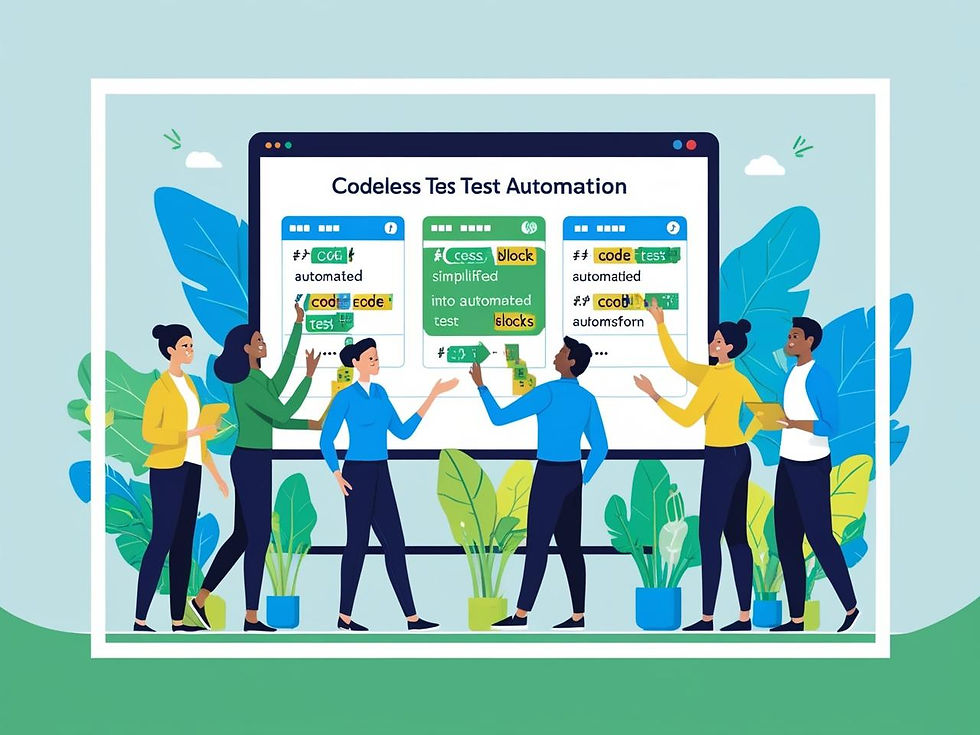Codeless Test Automation: A Game Changer for QA Teams
- digitalmuskan2244
- May 16
- 4 min read

The demand for faster, more efficient testing processes has never been higher in software testing. One of the most transformative advancements in recent years is codeless test automation. This approach is fundamentally changing the way Quality Assurance (QA) teams operate, making testing more accessible, agile, and effective. This article explores how codeless test automation is revolutionizing QA workflows, its benefits, tools, challenges, and future potential.
What is Codeless Test Automation?
Codeless test automation refers to the practice of automating tests without writing traditional code. Instead of scripting test cases in programming languages like Java or Python, testers use visual interfaces, drag-and-drop tools, or natural language processing to define test steps. This allows individuals without a strong programming background to contribute to test automation efforts.
These platforms abstract the technical complexities, enabling QA professionals, business analysts, and even product managers to create, execute, and manage automated test cases. As a result, codeless testing significantly broadens the pool of contributors and speeds up the entire testing process.
Why Codeless Test Automation Matters
Accessibility: Removes the need for coding skills, allowing non-technical stakeholders to participate in automation.
Faster Test Creation: Reduces time spent on writing and debugging scripts.
Agility: Easier to maintain and modify tests as applications evolve.
Cost-Effective: Reduces reliance on highly skilled automation engineers.
Collaboration: Encourages cross-functional collaboration between QA, development, and business teams.
In an agile or DevOps environment, where rapid release cycles are the norm, these advantages are vital. Codeless automation facilitates continuous testing, which in turn supports continuous integration and delivery (CI/CD) pipelines.
Key Features of Codeless Automation Tools
Modern codeless automation tools offer a range of features to make test automation more user-friendly and efficient:
Visual Workflow Designers: Drag-and-drop interfaces to build test cases.
AI and Machine Learning: Intelligent test creation, maintenance, and self-healing capabilities.
Record and Playback: Ability to record user interactions and convert them into automated scripts.
Cross-Platform Testing: Support for mobile, desktop, and web applications.
Cloud Integration: Enables remote execution and collaboration.
Version Control & Reporting: Built-in tools to manage test versions and generate detailed reports.
Popular codeless tools include Katalon Studio, TestCraft, Leapwork, Selenium IDE, and Testim.io. Each of these tools aims to simplify test automation while maintaining high performance and scalability.
Benefits to QA Teams
1. Lower Learning Curve: Traditional test automation requires learning a programming language and a test framework. Codeless tools eliminate this barrier, allowing more team members to participate in the testing process.
2. Increased Productivity: With intuitive UIs and drag-and-drop functionality, test cases can be created and modified much faster. This accelerates feedback loops and supports rapid development cycles.
3. Better Test Coverage: Since test creation is easier and faster, teams can achieve broader test coverage within the same time frame. This reduces the risk of bugs slipping into production.
4. Reduced Maintenance: AI-powered self-healing mechanisms identify changes in the UI or logic and adjust test scripts accordingly. This drastically reduces the maintenance overhead.
5. Improved Collaboration: Non-technical team members can contribute directly to test case creation and execution. This enhances understanding and alignment across teams.
Challenges and Limitations
Despite its advantages, codeless test automation is not a one-size-fits-all solution. There are still challenges that teams need to be aware of:
Scalability: Some codeless tools may struggle with complex workflows or large-scale testing.
Customization: Limited flexibility for writing highly customized test cases.
Tool Lock-In: Proprietary platforms may lead to dependency and lack of portability.
False Sense of Simplicity: Teams may underestimate the planning and test strategy required.
These challenges can be mitigated through careful tool evaluation, training, and integrating codeless automation into a broader test strategy.
Best Practices for Implementing Codeless Test Automation
Start Small: Begin with simple, repetitive test cases and gradually scale up.
Choose the Right Tool: Match tool capabilities with your project needs.
Train the Team: Even codeless tools require some training to use effectively.
Integrate with CI/CD: Ensure the tool supports your existing pipelines.
Monitor & Optimize: Continuously analyze test performance and refine strategies.
The Future of Codeless Test Automation
As software development continues to embrace agility and speed, the demand for smarter, easier testing solutions will grow. Codeless automation is poised to evolve with the help of AI, machine learning, and natural language processing.
Future developments may include:
More advanced AI for self-healing and intelligent test creation.
Greater support for hybrid approaches (code + codeless).
Improved integration with DevOps toolchains.
Broader adoption across industries beyond tech.
QA teams that embrace these tools now will be well-positioned to adapt to future demands.
Getting Started: Upskill with the Right Training
To take full advantage of codeless test automation, QA professionals must still understand the fundamentals of software testing. A structured learning path ensures you have the knowledge to make strategic decisions about which tools to use, how to design test cases, and how to integrate automation into larger workflows.
For those looking to build or upgrade their skills, enrolling in a comprehensive software testing course in Noida, Delhi, Lucknow, Meerut, and other cities in India can be an excellent first step. These programs offer hands-on training, real-world projects, and exposure to the latest tools, preparing you for the future of testing.
Conclusion
Codeless test automation is more than a passing trend—it’s a revolutionary approach that empowers QA teams to move faster, collaborate better, and deliver higher-quality software. While it's not without challenges, the benefits make it a compelling choice for many organizations. As tools become more intelligent and integrated, codeless testing will play a central role in modern QA strategies.
Whether you're a seasoned tester or a newcomer, now is the time to explore this powerful paradigm shift and prepare yourself for the next era of software testing.







Comments